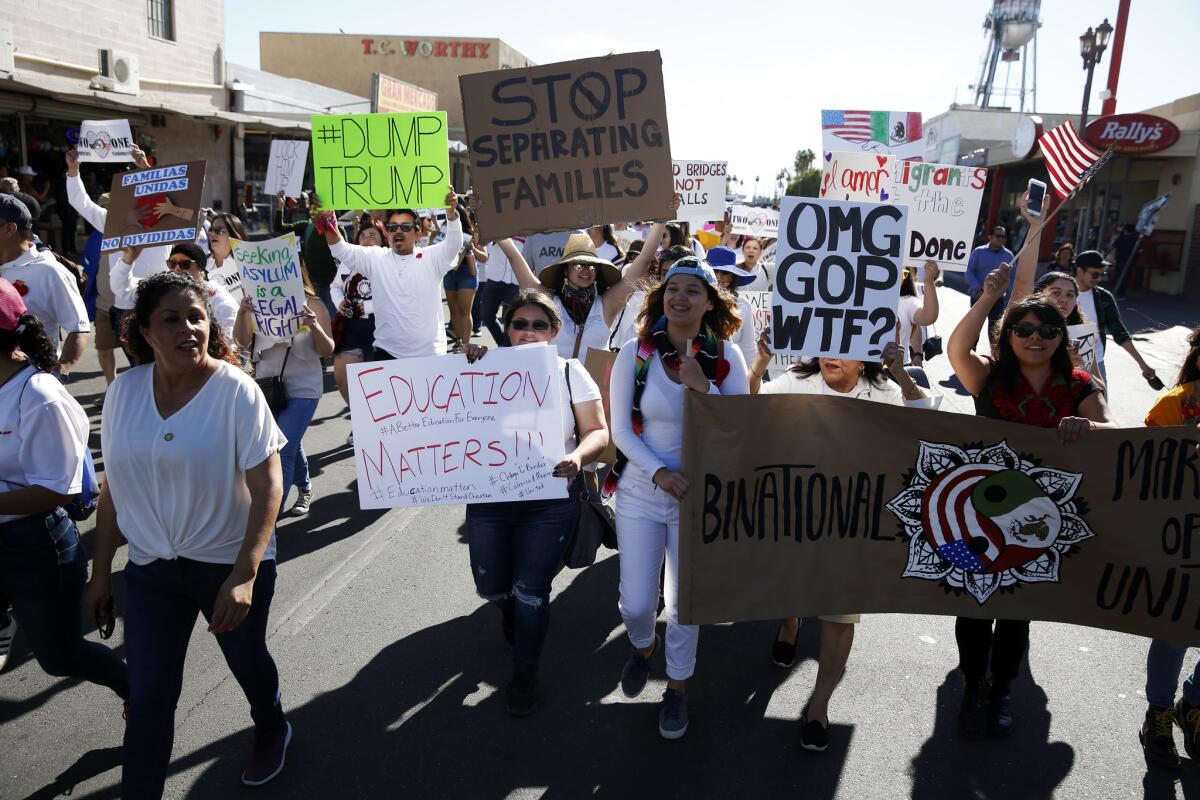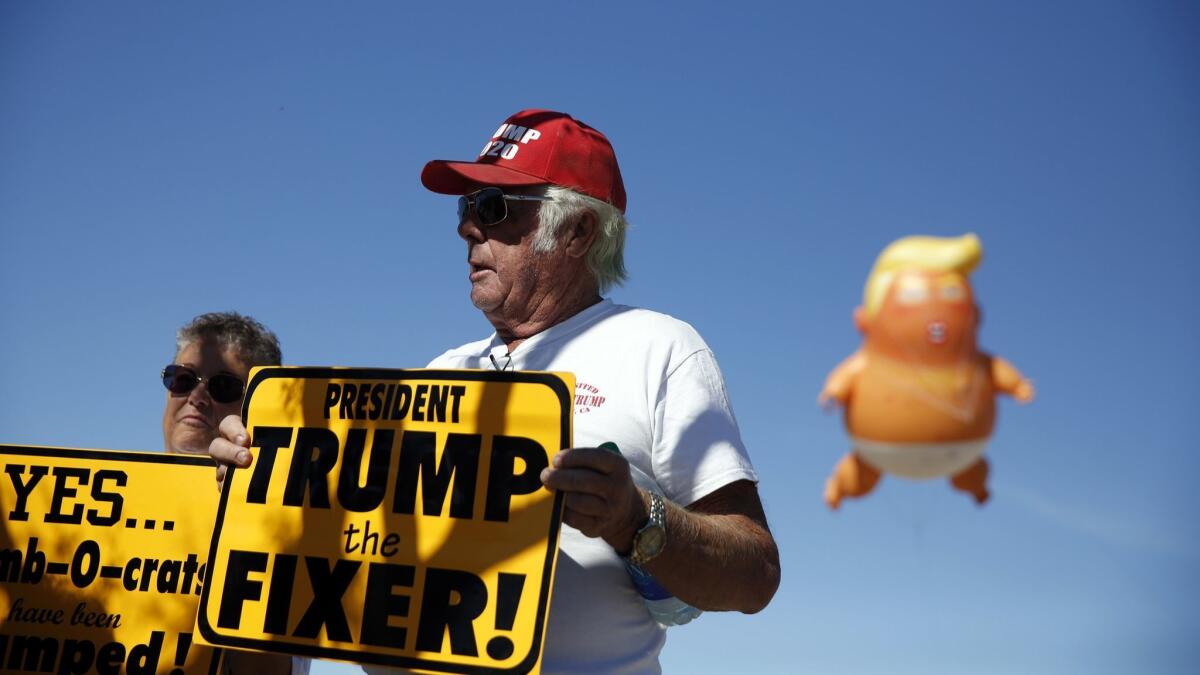Column: Trump’s threat roils Calexico, where a border closure could spell disaster

- Share via
Reporting from Calexico, Calif. — A giant inflatable baby Trump floated over the crowd of protesters who gathered Friday morning here at the Mexican border, next to the new outlet mall that was supposed to bring salvation to this economically depressed city.
They were mad about President Trump’s threat to close the border, but the purpose of the march was to demonstrate unity with Mexicali, Calexico’s sister city across the border.
“We are interconnected. We are one community. We are not separated,” said Jose Luis Olmedo of Comite Civico del Valle, an Imperial Valley civil rights group.
Trump swooped into town Friday to flog his nonexistent border “emergency” on his way to a Beverly Hills fundraiser. The protesters hoped to catch a glimpse of the man who has the power, with the stroke of a pen, to screw up their jobs, their health and their families. Or, more to the point, that he would catch a glimpse of them.
Sadly, the chubby orange-haired balloon was the only version of Trump they saw. After a couple of hours of speeches, music and chanting, they lined the sidewalk on West 2nd Street waiting in vain for Trump’s motorcade. The president had taken a different route.
No one around here seems to know whether to take Trump’s threat seriously, but plenty of people believe he is erratic enough to follow through.
Which could be a disaster.
“Without Mexican shoppers,” said Imperial County Supervisor Ray Castillo, who addressed the protesters, “our economy can’t survive. It would break us.”
When I reached her by phone the day before Trump’s visit, Calexico native Hildy Carrillo, executive director of the local chamber of commerce, was even blunter. “If he closes the border,” she said, “just shoot us.”
On Thursday, Trump rescinded his threat to shut down the border, vowing instead to give Mexico another year to solve the Central American refugee problem and end the flow of illegal drugs.
To Calexicans, those are not the pressing issues.
“Our crisis is poverty, lack of housing, air pollution,” said Eric Reyes, an advocate for farmworkers, as protesters broke into a spontaneous rendition of “God Bless America.”

::
Calexico is a city of about 39,000 two hours east of San Diego. It lies directly across the border from Mexicali, the capital of Baja California and a relative megalopolis of nearly 700,000.
Calexico’s commerce depends on Mexican shoppers, who walk or drive across by the thousands. The colonnaded sidewalks in old downtown draw shoppers to modest-priced clothing boutiques, budget stores and pawn shops. There is a satellite campus of San Diego State here, one Starbucks and a lot more Chinese restaurants than you’d expect.
During the day, Calexico’s population doubles.
The traffic goes both ways; agricultural crops that surround Calexico in the fertile Imperial Valley are picked by farmworkers who legally cross the border from Mexico every day during the picking seasons. They board buses and are whisked away to the fields to harvest lettuce, cabbage, carrots, beets and broccoli.
What would a border closure look like in a town like Calexico, which for all intents and purposes is part of the greater Mexicali area?

“Do you remember 9/11 when they closed the border?” Carrillo asked. “Our streets were bare. No traffic. You could hear the birds chirp. There was a tumbleweed rolling down the main street. It would be like that.”
It’s hard to describe how conjoined the two places are. Even the names Calexico and Mexicali — portmanteaus of California and Mexico — reflect a deep entanglement. “The border doesn’t exist for this area,” Carrillo said.
It is common for residents of Calexico to get dental and medical care in Mexicali, which has first-rate hospitals and a large number of doctors and dentists.
Insurance companies routinely send their American patients to Mexicali for care, said Esther Bejarano, an environmental activist who had turned out at the protest to talk about a real border emergency: air quality.
This region has some of the worst air pollution in the country and the highest rate of asthma-related emergency room visits by children in California. Because of that, Bejarano said, it is not uncommon for American schoolkids to seek treatment for asthma in Mexicali, which puts them in an impossible bind. Their American schools require them to register their inhalers, but schools won’t register medicines from Mexico. Children are forced to carry their inhalers in their backpacks, like contraband.
Rudy Huerta, 66, a retired warehouse supervisor for a beer distributor, lives in Calexico but gets his medication and dental work in Mexicali. He even gets his hair cut there.
I bumped into him on West 2nd Street next to the Gran Plaza Outlets, where nearly 40 big-name retailers draw shoppers from Mexicali. He stood with about 300 people who were hoping to see the president, or at least his limo.
Huerta told me he lives on $1,800 a month from Social Security, plus withdrawals from his 401(k).
His dentist on the American side wanted to yank his teeth and charge $10,000 for implants. A dentist on the Mexican side fixed his existing teeth for $500. His prescription glasses, which would have cost $500 in the U.S., cost him $60 in Mexico. And that included the exam.
“I have to go over because it’s so much cheaper,” he said. “But what if they close the border and I get sick?”
::
Trump touched down in Calexico in the early afternoon for a roundtable discussion with immigration officials, law enforcement officers and politicians, including U.S. Rep. Duncan Hunter, who is facing federal charges of misappropriating campaign funds.
Based on transcripts, Trump seems to have spent his time crowing about the wall and the border’s “absolute emergency,” blaming Democrats for a dysfunctional immigration system and congratulating himself for deporting gang members.
“Nobody’s ever done the job we’ve done,” he said.
The president then briefly visited the border fence, having claimed, wrongfully and repeatedly, that the 2¼-mile steel-slat fence that separates Calexico from Mexicali was built on his initiative. Its construction, in fact, was planned during the Obama administration as an upgrade to an existing fence. The upgrade was requested by border officials because the previous fence was solid, made of Vietnam-era surplus landing mats. “If somebody threw a bottle of beer over the fence,” Carrillo said, “they couldn’t see where it was coming from. Now they have a clear view. Aesthetically, it looks better.”
If you look closely, however, there is an unexpected addition to the long-planned fence.
Last November, the National Guard unfurled shiny silver spirals of razor wire across the top of the fence. They also snuggled double rows of the wire along the base. This, presumably, will keep out the vicious hordes of Central American parents and children who turn themselves in to border officials to apply for political asylum in the United States.
Thieves have already begun stealing the concertina wire, reselling it to people who live on the Mexican side — especially in high-crime Tijuana — where it has mysteriously turned up on the fences and roofs of private homes.
I don’t approve of larceny, but that’s some good old-fashioned cross-border ingenuity at work.
Twitter: @AbcarianLAT
More to Read
Sign up for Essential California
The most important California stories and recommendations in your inbox every morning.
You may occasionally receive promotional content from the Los Angeles Times.











